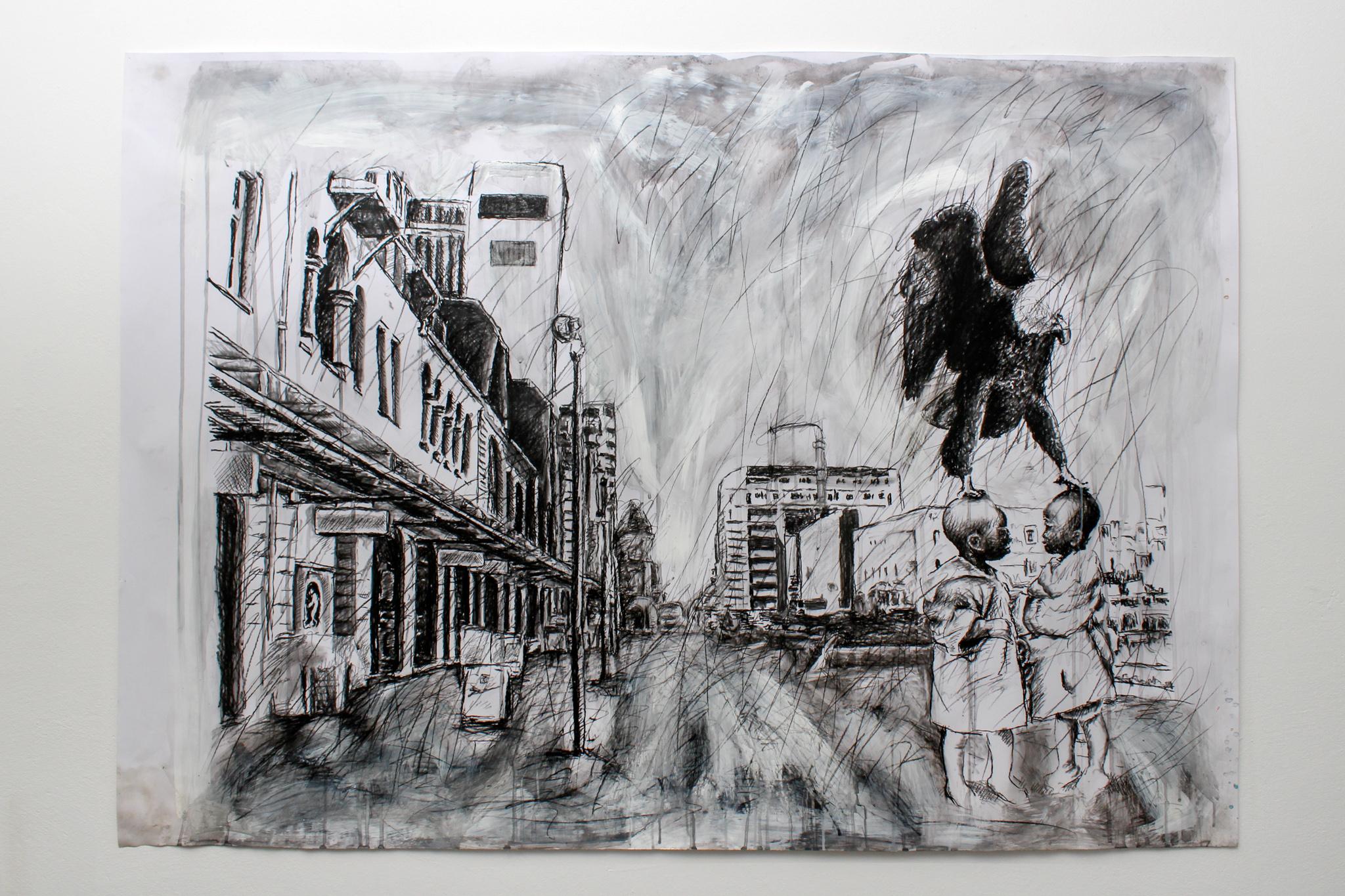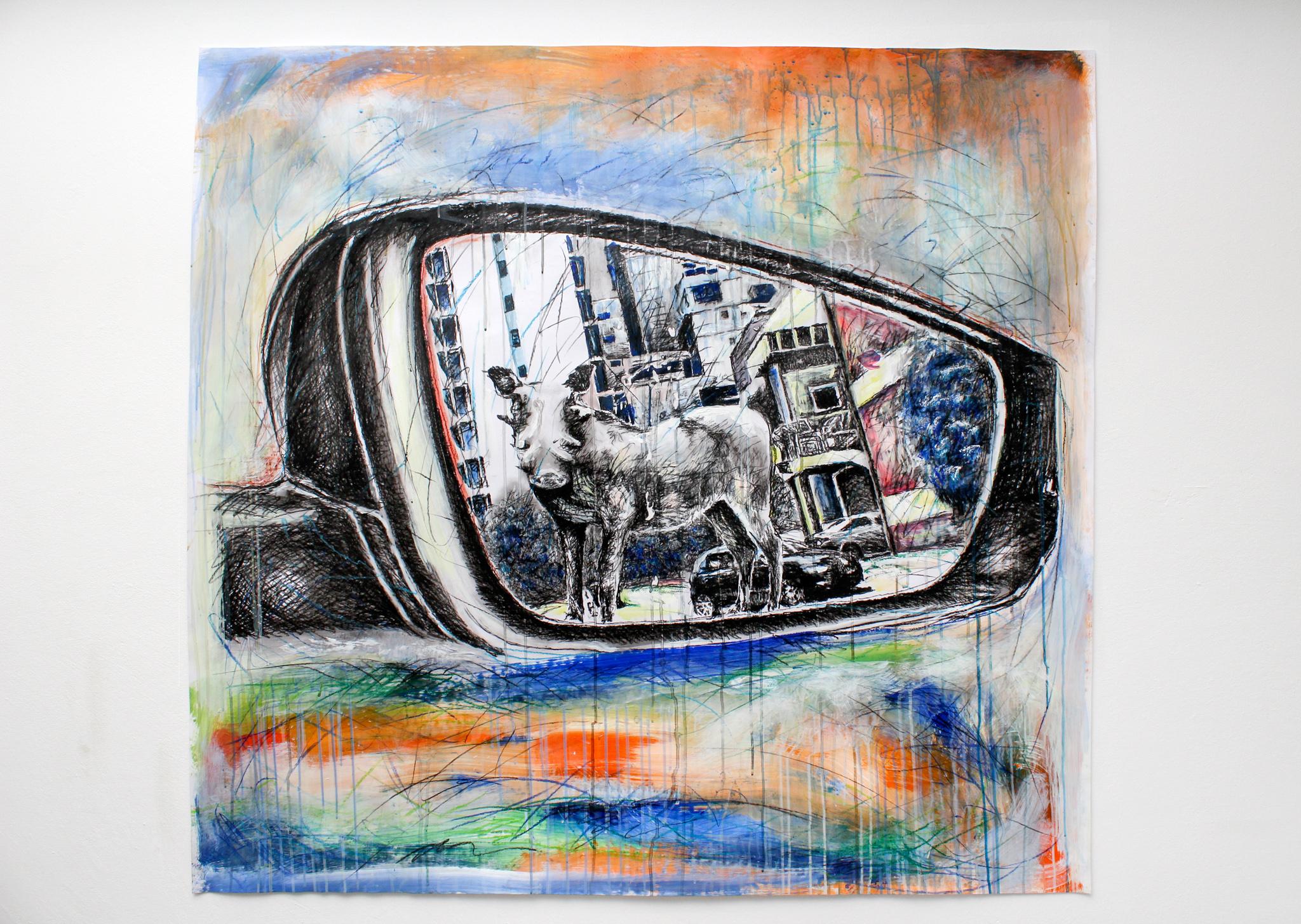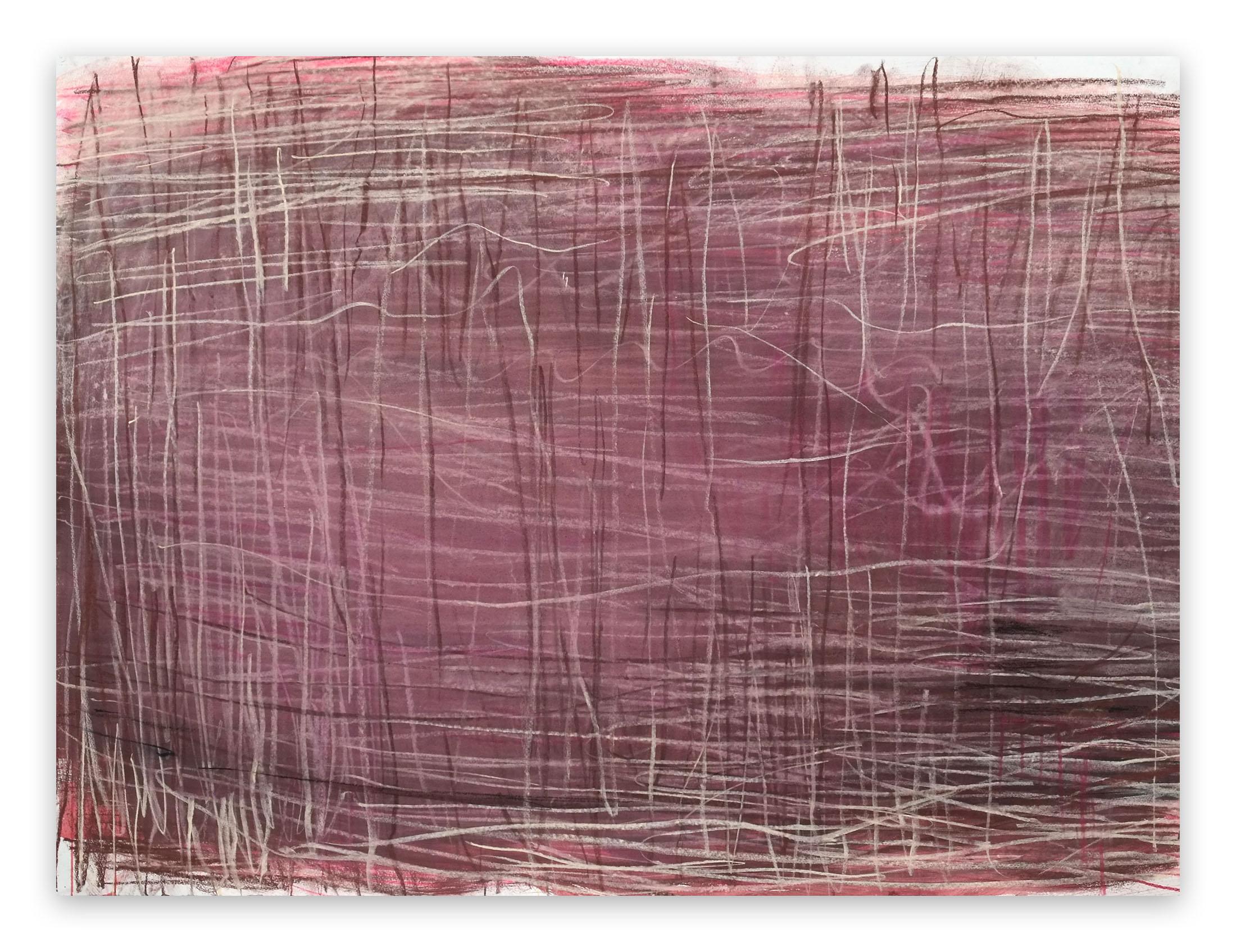Items Similar to "Untitled" Lyrical, Colorist, Abstract, Color Field Blue Pastel on Paper
Want more images or videos?
Request additional images or videos from the seller
1 of 8
Michael Goldberg"Untitled" Lyrical, Colorist, Abstract, Color Field Blue Pastel on Paper1969
1969
About the Item
Michael Goldberg
Untitled, 1969
Signed and dated lower right
Pastel on paper
8 x 8 inches
Born December 24, 1924, in New York City, Michael Goldberg continued to live and work in Manhattan. He began his artistic training at the Art Students League in New York (1938) and attended Hans Hofmann's School of Fine Art (1941-1942) before interrupting his studies to serve as a paratrooper in the United States Army in North Africa, China, Burma, and India. After World War II, he resumed his classes with Hofmann. He became involved in the avant-garde New York art scene, meeting Franz Kline, Willem de Kooning, Jackson Pollock, and Milton Resnick among others. In 1951, Goldberg, under the name Michael Stuart, showed his paintings in the "Ninth Street Show," arguably the first comprehensive display of Abstract Expressionist work. The following year he moved to 28 East 2nd Street and joined the artists' "Club" on Eighth Street, gathering with other Abstract Expressionist painters to exchange artistic ideas.
Around this time, he met the poet Frank O'Hara, who became a life-long friend and dedicated many poems to Goldberg. In addition, they collaborated on a project titled "Odes" in 1960. Goldberg maintained his connection with the Abstract Expressionist painters throughout the fifties and into the sixties. By 1953, he was a regular at Cedar Bar, known as a meeting place for avant-garde artists. Two years later, he moved into a studio next to that of De Kooning and Resnick. In 1962, he acquired Mark Rothko's studio at 222 Bowery where he worked until his death.
Teaching has played a central role in Goldberg's career. He has held visiting artist positions at the University of California, Berkeley (1961) and the University of Minnesota (1967) and has taught at the School of Visual Arts in New York City since 1979. Beginning in 1980, accompanied by his wife, the artist Lynn Umlauf, he has spent long summers in Italy. Many of his later pictures are inspired by Italy's celebrated artistic heritage.
Goldberg's work defies classification, having undergone numerous changes throughout his long and prolific career. He has painted dynamic, gestural canvases; monochromatic, minimalist works; grids; calligraphic images; patterned or striped paintings, and he has experimented with collage. By 2003, he had had 99 solo exhibitions since his first show at Tibor de Nagy in New York in 1953. His pictures are in numerous public collections in the United States, including the Albright-Knox Art Gallery, Buffalo, New York; the Art Institute of Chicago; the Hirshorn Museum and Sculpture Garden, Smithsonian Institution, Washington, D.C.; The Museum of Modern Art, New York; the Philadelphia Museum of Art; the Solomon R. Guggenheim Museum, New York; and the Whitney Museum of American Art, New York.
- Creator:Michael Goldberg (1924-2007, American)
- Creation Year:1969
- Dimensions:Height: 10 in (25.4 cm)Width: 10 in (25.4 cm)
- More Editions & Sizes:Unique workPrice: $3,250
- Medium:
- Movement & Style:
- Period:
- Condition:
- Gallery Location:New York, NY
- Reference Number:1stDibs: LU1841214463182
Michael Goldberg
Michael Goldberg, a second generation Abstract Expressionist painter known for his action-packed, gestural canvases, went through several phases that included monochromatic works of red and then black, bands of white on black, caligraphic images and bright bands of color hinting of architectural forms. Ever aligned with Abstract Expressionism which he described in 2001 as "still the primary visual challenge of our time", he later shrugged off the designation saying "labels come and go". (Glueck) He was also an art educator who taught at the University of California, Berkeley from 1961 to 1962; Yale University in 1967; and the University of Minnesota in 1968. He and his artist wife, Lynn Umlauf, both taught at the School of Visual Arts in New York city. Goldberg was born in 1924 in the Bronx of New York City. His studies at the Art Students League, 1938-1942, were interrupted by World War II where he served as a paratrooper in North Africa and Burma, making eighty jumps behind Japanese lines. Returning to New York, he studied with Jose de Creeft and Hans Hofmann, and Hoffman remained a strong influence. He was also influenced by Roberto Matta and Arshile Gorky, but it was Willem de Kooning, and his use of fiery brush-work and explosive color, who would prove to be Goldberg's greatest influence. Beginning 1980, he spent five months of each year in Tuscany, Italy on an estate near Siena. In his studio there, he created many of his signature paintings done with oil sticks pressed directly onto canvas. He described these as quasi grids, "patchy squares of color intersected at random by strong diagonals." (Glueck) Goldberg participated in the dealer Leo Castelli’s ground- breaking Ninth Street Show in 1951, which included works by Mitchell, Jackson Pollock, and Robert Motherwell; “he seemed to embody the attitudes shared by the artists of that group,” said Richard Kalina of Goldberg (“Michael Goldberg 1924–2007.” Art in America, March 2008). Two years later Goldberg received his first solo show at the Tibor de Nagy Gallery. In 1955, Goldberg befriended fellow Abstract Expressionist painter Norman Bluhm, which proved to be a fateful meeting. In 1956, Bluhm brought art collector Walter P. Chrysler, Jr. to Goldberg’s studio, and Chrysler purchased 17 of his paintings. With new interest in his work, Goldberg caught the eye of art dealer Martha Jackson and was soon represented by her gallery.
About the Seller
5.0
Platinum Seller
These expertly vetted sellers are 1stDibs' most experienced sellers and are rated highest by our customers.
Established in 2021
1stDibs seller since 2022
63 sales on 1stDibs
Typical response time: <1 hour
- ShippingRetrieving quote...Ships From: New York, NY
- Return PolicyA return for this item may be initiated within 3 days of delivery.
More From This SellerView All
- "Untitled" 1970s Color Field Pastel on Paper, Abstract Blue CompositionBy Michael GoldbergLocated in New York, NYMichael Goldberg Untitled, 1974 Signed and dated lower right Watercolor on paper 15 x 11 inches Born December 24, 1924, in New York City, Michael Goldberg continued to live and wor...Category
1970s Abstract Abstract Paintings
MaterialsPaper, Pastel
- "Two Figures, " Louis Stone, Abstract, American WPA ModernismBy Louis StoneLocated in New York, NYLouis K. Stone (1902 - 1984) Two Figures, 1980 Mixed media on paper Sight 52 x 42 inches Signed and dated lower right Louis King Stone was born in Findlay, Ohio in 1902 and received...Category
1980s Abstract Abstract Paintings
MaterialsPaper, Mixed Media
- "Repetition" Chryssa, Greek Female Artist, Abstract, Neon Light Art StudyBy Chryssa Vardea-MavromichaliLocated in New York, NYChryssa Repetition Signed lower right; titled on the reverse Gouache, watercolor, charcoal, and graphite on paper 15 x 11 inches Born and educated in Athens, Greece, Vardea Chryssa, known professionally as Chryssa, became a U.S. citizen and earned a reputation for her sculptured assemblages utilizing light from neon, and plexiglas combined with mixed media pieces. One of her pieces, Untitled Light Sculpture (1980) is 22 feet long and is installed in the atrium of a building at 33 Monroe Street in Chicago. It was programmed electronically to create changing patterns of reflected light through 900 feet of neon tubing. Chryssa's sculptures with precision and definite form were a reaction against the prevalent Abstract Expressionism of the 1950s with its emphasis purely upon the artist's intent. In her work, the focus is on materials and the way they are shaped for specific use by craftsmen. She got her early education in Athens, and first studied to be a social worker. She was then sent by the Greek Ministry of Social Welfare to the Dodecanese Islands and later to the Ionian Sea island of Zante, whose population had suffered great loss from earthquakes. Disillusioned that monies were being provided to restore monasteries but not to help other earthquake victims, Chryssa changed her life's direction to become a painter. In Athens, she studied art with Anghelos Prokopion. Then she went to Paris, France, and studied briefly at the Academie Grande Chaumiere and associated with surrealists Andre Breton, Edgard Varese, and Max Ernst. In 1954, she moved to San Francisco, California for a year of study at the California School of Fine Arts, and there she first saw the work of Jackson Pollock, which had a freeing affect on her and inspired her to experiment with pure form. But later she reacted against action painting with her assemblage sculptures of controlled precision. In 1955, Chryssa settled in New York City, and became the first artist to incorporate neon light tubing and commercial signs into sculpture. It is asserted that her "mature work grew out of the Greek experience, before and after World War II, wedded to the raucous letters, signs, symbols, and lights of Time Square, New York City" (Heller 125). In fact, she was so taken with the lights of Times Square that she unsuccessfully tried to get a job as a sign maker but was prevented by labor union rules. However, one of the members gave her sign-making lessons in his shop. She first made Pop images such as depictions of automobile tires and cigarettes and in sculptures, utilized letters of the alphabet, ideas that predated similar images by Jasper Johns and Andy Warhol. Her first major work of interwoven light and letters was Times Square Sky of 1962, but she was dissatisfied because she thought the piece was too crowded. To create a sense of breathing, she inserted neon light, and for the first time, this material became an art medium. From that time, she was prolific and created many variations based on the letters W and A. For her, a primary motivating factor was remaining cool or mentally collected amidst the onslaught of bombarding information and to process it through her creations in new ways so that nothing was repeated. She set up her own work place...Category
Late 20th Century Abstract Abstract Paintings
MaterialsGouache, Graphite, Paper, Charcoal, Watercolor
- "Tiny Travelers, " Alan Fenton, Abstract Expressionism, New York School, StripesLocated in New York, NYAlan Fenton (1927 - 2000) Tiny Travelers II, 1975 Watercolor on paper 23 x 17 inches Signed and dated lower right; titled lower left Fenton's quiet and co...Category
1970s Abstract Expressionist Abstract Paintings
MaterialsPaper, Watercolor
- "Composition with Figure, " Irene Rice PereiraBy Irene Rice PereiraLocated in New York, NYIrene Rice Pereira Composition with Figure, 1951 Inscribed, signed and dated Salford/Pereira 2/51 (lr); inscribed I Rice Pereira/2669 Great Clowes St/Sa...Category
1950s Abstract Abstract Paintings
MaterialsPaper, India Ink, Casein
- "Cronus Dining" David Hare, Yellow and White Composition on Paper, AbstractBy David HareLocated in New York, NYDavid Hare Cronus Dining, 1968 Graphite, acrylic, paper collage on board 44 x 34 inches “Freedom is what we want,” David Hare boldly stated in 1965, but then he added the caveat, “and what we are most afraid of.” No one could accuse David Hare of possessing such fear. Blithely unconcerned with the critics’ judgments, Hare flitted through most of the major art developments of the mid-twentieth century in the United States. He changed mediums several times; just when his fame as a sculptor had reached its apogee about 1960, he switched over to painting. Yet he remained attached to surrealism long after it had fallen out of official favor. “I can’t change what I do in order to fit what would make me popular,” he said. “Not because of moral reasons, but just because I can’t do it; I’m not interested in it.” Hare was born in New York City in 1917; his family was both wealthy and familiar with the world of modern art. Meredith (1870-1932), his father, was a prominent corporate attorney. His mother, Elizabeth Sage Goodwin (1878-1948) was an art collector, a financial backer of the 1913 Armory Show, and a friend of artists such as Constantin Brancusi, Walt Kuhn, and Marcel Duchamp. In the 1920s, the entire family moved to Santa Fe, New Mexico and later to Colorado Springs, in the hope that the change in altitude and climate would help to heal Meredith’s tuberculosis. In Colorado Springs, Elizabeth founded the Fountain Valley School where David attended high school after his father died in 1932. In the western United States, Hare developed a fascination for kachina dolls and other aspects of Native American culture that would become a recurring source of inspiration in his career. After high school, Hare briefly attended Bard College (1936-37) in Annandale-on-Hudson. At a loss as to what to do next, he parlayed his mother’s contacts into opening a commercial photography studio and began dabbling in color photography, still a rarity at the time [Kodachrome was introduced in 1935]. At age 22, Hare had his first solo exhibition at Walker Gallery in New York City; his 30 color photographs included one of President Franklin Roosevelt. As a photographer, Hare experimented with an automatist technique called “heatage” (or “melted negatives”) in which he heated the negative in order to distort the image. Hare described them as “antagonisms of matter.” The final products were usually abstractions tending towards surrealism and similar to processes used by Man Ray, Raoul Ubac, and Wolfgang Paalen. In 1940, Hare moved to Roxbury, CT, where he fraternized with neighboring artists such as Alexander Calder and Arshile Gorky, as well as Yves Tanguy who was married to Hare’s cousin Kay Sage, and the art dealer Julian Levy. The same year, Hare received a commission from the American Museum of Natural History to document the Pueblo Indians. He traveled to Santa Fe and, for several months, he took portrait photographs of members of the Hopi, Navajo, and Zuni tribes that were published in book form in 1941. World War II turned Hare’s life upside down. He became a conduit in the exchange of artistic and intellectual ideas between U.S. artists and the surrealist émigrés fleeing Europe. In 1942, Hare befriended Andre Breton, the principal theorist of surrealism. When Breton wanted to publish a magazine to promote the movement in the United States, he could not serve as an editor because he was a foreign national. Instead, Breton selected Hare to edit the journal, entitled VVV [shorth for “Victory, Victory, Victory”], which ran for four issues (the second and third issues were printed as a single volume) from June 1942 to February 1944. Each edition of VVV focused on “poetry, plastic arts, anthropology, sociology, (and) psychology,” and was extensively illustrated by surrealist artists including Giorgio de Chirico, Roberto Matta, and Yves Tanguy; Max Ernst and Marcel Duchamp served as editorial advisors. At the suggestion of Jacqueline Lamba...Category
1960s Abstract Abstract Paintings
MaterialsPaper, Acrylic, Graphite
You May Also Like
- 1960s Gloria Dudfield Bay Area Figurative Orange, Yellow Gray Pastel and PaintBy Gloria DudfieldLocated in Arp, TXGloria Dudfield (1922-2015) Untitled c.1960s Mixed media: gouache, pastel and encaustic on newsprint 11"x15.5" unframed Unsigned Gloria (Fischer) Dudfield July 12, 1922 – May 27, 20...Category
1960s Abstract Abstract Paintings
MaterialsPaper, Pastel, Encaustic, Gouache
- ARIETTA 5 (Abstract drawing)By Margaret NeillLocated in London, GBARIATTA 5 (Abstract drawing) Pastel and acrylic on paper - Unframed. Margaret Neill works for a time on a group of pieces in a series, using classic almost primal materials such as...Category
2010s Abstract Abstract Paintings
MaterialsAcrylic, Paper, Pastel
- ARIETTA 3 (Abstract drawing)By Margaret NeillLocated in London, GBARIATTA 3 (Abstract drawing) Pastel on paper - Unframed. Margaret Neill works for a time on a group of pieces in a series, using classic almost primal materials such as graphite, c...Category
2010s Abstract Abstract Paintings
MaterialsPaper, Pastel
- ARIETTA 6 (Abstract drawing)By Margaret NeillLocated in London, GBARIATTA 6 (Abstract drawing) Pastel and acrylic on paper - Unframed. Margaret Neill works for a time on a group of pieces in a series, using classic almost primal materials such as...Category
2010s Abstract Abstract Paintings
MaterialsPaper, Pastel, Acrylic
- “Urban Interstitial Abstraction #19” – Charcoal and Pastel on PaperBy Trevor NorrisLocated in West Hollywood, CATrevor Norris was born into a large family living in a small but brightly painted english row house. Life inside was turbulent and colorful. Norris's art is a personal reflection usi...Category
2010s Abstract Abstract Paintings
MaterialsCharcoal, Pastel, Archival Paper
- “Urban Interstitial Abstraction #18” – Charcoal and Pastel on PaperBy Trevor NorrisLocated in West Hollywood, CATrevor Norris was born into a large family living in a small but brightly painted english row house. Life inside was turbulent and colorful. Norris's art is a personal reflection usi...Category
2010s Abstract Abstract Paintings
MaterialsCharcoal, Pastel, Archival Paper
Recently Viewed
View AllMore Ways To Browse
Michael Summers
Chinese New Year Vintage
Striped Paintings
Han Solo
Franz Mark
Buffalo Studios
Vintage Chicago Street Sign
Chicago Street Scene
Rothko Inspired
R Frank
C Knox
Fifties Sixties
Michael Jackson Signed
De Kooning Sculpture
Warring States Chinese
De Kooning Franz Kline
Grid Paper Vintage
Vintage Bar Chicago






